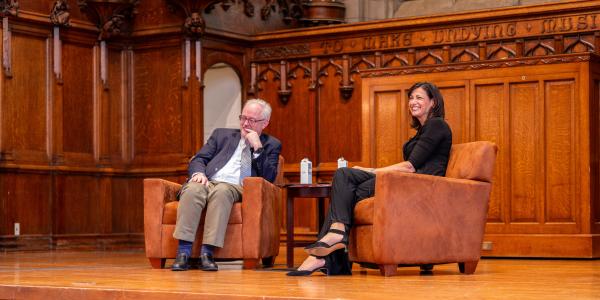The former CDC director reflected on the importance of transdisciplinary education, the need for integrated data, and the vital role of public health in responding to emerging threats.

Dr. Rochelle Walensky, BA ’91, returned to her alma mater this month with an important message: Universities can no longer think about medicine and health policy as separate and distinct fields.
An infectious disease expert who served as director of the Centers for Disease Control and Prevention during the recent pandemic, Walensky has had an up-close view of the value of public health education for clinicians, administrators, and policymakers.
“There’s a deficit of public health workers,” she said. “We need to train the next generation.”
Walensky shared her thoughts in conversation with Dr. William Powderly, the J. William Campbell Professor of Medicine. The April 11 event was presented in service of Public Health at WashU and supported by Arts & Sciences and the Institute for Public Health.
The COVID-19 pandemic was not Walensky’s first experience on the front lines of a public health crisis. Early in her career, she worked at an inner-city health department in Baltimore in 1995, the year effective treatments for HIV first became available. More than 20 years later, she found herself facing yet another health crisis — this time worsened by misinformation, access disparities, and massive gaps in public health infrastructure.
Through it all, Walensky has been guided by a passion to make a difference through public health advocacy. She recalled feeling both angered and inspired by government policies that perpetuated health inequalities and hampered public health initiatives.
“I really wanted to have a seat at the policy table,” she said. “I accomplished that through science.”
Here are five key takeaways from the conversation:
1. Researchers should work together to break down academic silos and solve pressing health problems.
In too many places, medical education is extremely fragmented, Walensky said. Doctors in a particular field can go through years of training without ever setting foot in the world of public health. But infectious diseases don’t respect such boundaries, and public health is an issue that encompasses many parts of society. “I often talk to people about how public health policy can affect education or the workforce or the economy,” she said.
Universities, medical schools, and public health departments must cooperate to dismantle barriers between fields to fully prepare the next generation of public health experts for the interdisciplinary challenges ahead, she said.
2. Understanding government can improve public health policies.
As Walensky moved from clinical medicine to government, she quickly realized her new job required more than a knowledge of public health. “You have to know what it means to make a policy,” she said. Policies made in one department can have implications in multiple areas, sometimes with unintended consequences.
“In our training of the next generation, there are opportunities for government internships and ways to connect that to public health schools. Getting practical experience out in the field of government is really helpful.”
That understanding runs both ways. Governments must also work to build trust with citizens, a task requiring effective communication and a commitment to transparency. The pandemic highlighted the life-or-death implications of these relationships. “The countries that did best with COVID were the countries that trusted their governments,” she said.

3. Integrated data systems could lead to more effective public health solutions.
Walensky pointed to a shortage of public health workers versed in data analysis, a problem that became evident during her many conversations with public health departments around the country during the pandemic. “They have people trained in data entry but not data analysis,” she said.
A lack of integrated data systems also hampers responses to public health emergencies, Walensky said. The CDC received COVID-19 data from 50 states and more than 3,000 counties, she said, but there was no standard for reporting. “That data didn’t tell us what was going on during the pandemic.” Having integrated data systems — and people trained to analyze the data — could greatly improve the government’s response to the next crisis, she said.
4. Addressing the urban-rural divide in public health requires innovative thinking.
Large swaths of the country lack a medical school, Walensky said. When COVID-19 arrived in the U.S., 80% of counties lacked a single expert trained in infectious diseases. “Access is a huge issue,” she said. “I’ve thought a lot about how we need to partner with congressional districts to create training programs.”
5. Public health isn't just about humans.
When asked what looming danger kept her up at night, Walensky quickly answered: The potential flow of infectious disease from animals to humans. “There's an estimate that 75% of new infections are due to the human-animal interface,” she said. “It’s going to be a huge issue moving forward.” Whatever crisis comes next, she said, we’ll need public health experts up to the challenge.






